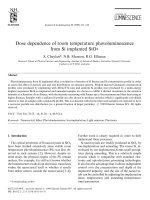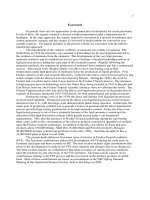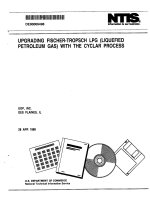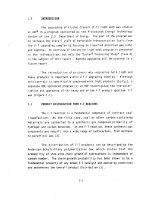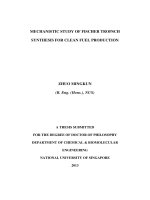sio 2 supported fe femn colloids fischer tropsch synthesis on 3d model catalysts
Bạn đang xem bản rút gọn của tài liệu. Xem và tải ngay bản đầy đủ của tài liệu tại đây (1.59 MB, 22 trang )
Accepted Manuscript
Title: SiO2 -supported Fe and FeMn
colloids—Fischer-Tropsch Synthesis on 3D model catalysts
Authors: Mohammadhassan Dad, Remco J. Lancee, Matthys
Janse van Vuuren, Jan van de Loosdrecht, J.W. Hans
Niemantsverdriet, Hans O.A. Fredriksson
PII:
DOI:
Reference:
S0926-860X(17)30089-3
/>APCATA 16159
To appear in:
Applied Catalysis A: General
Received date:
Revised date:
Accepted date:
20-12-2016
24-2-2017
28-2-2017
Please cite this article as: Mohammadhassan Dad, Remco J.Lancee, Matthys Janse van
Vuuren, Jan van de Loosdrecht, J.W.Hans Niemantsverdriet, Hans O.A.Fredriksson,
SiO2-supported Fe and FeMn colloids—Fischer-Tropsch Synthesis on 3D model
catalysts, Applied Catalysis A, General />This is a PDF file of an unedited manuscript that has been accepted for publication.
As a service to our customers we are providing this early version of the manuscript.
The manuscript will undergo copyediting, typesetting, and review of the resulting proof
before it is published in its final form. Please note that during the production process
errors may be discovered which could affect the content, and all legal disclaimers that
apply to the journal pertain.
SiO2-supported Fe & FeMn colloids - FischerTropsch Synthesis on 3D model catalysts
Mohammadhassan Dada, Remco J. Lanceea, Matthys Janse van Vuurenb, Jan van de
Loosdrechtb, J.W. (Hans) Niemantsverdrietc and Hans O. A. Fredrikssona,c,*
Laboratory for Physical Chemistry of Surfaces, Eindhoven University of Technology, P.O. Box 513,
5600 MB Eindhoven, The Netherlands
a
b
Sasol, Group Technology, P.O. Box 1, Sasolburg 1947, South Africa
cSynCat@DIFFER,
Syngaschem BV, P.O. Box 6336, 5600 HH Eindhoven, The Netherlands
*Corresponding author, E-mail: (H. O. A. Fredriksson)
Graphical abstract
HighLights
A three dimensional, non-porous, monodisperse model catalysts has been developed
The model catalyst, (Fe on SiO2) has been tested during industrial Fischer-Tropsch synthesis
conditions
The addition of a Mn promoter increases Fe-catalyst stability and influences reaction selectivity
Exhaustive catalyst characterization has been performed revealing carbon encapsulation,
sintering and phase changes in the active materials
Abstract
A well-defined model catalyst constituting a compromise between high surface area,
porous, industrial catalysts and a planar model catalyst has been developed. It allows for
measurements of catalytic activity in micro reactors, where diffusion problems are kept at a
minimum, while characterization both by surface science techniques and by bulk techniques
can be applied. Monodisperse, non-porous SiO2 microspheres with diameter 875 ± 25 nm have
been synthesized, serving as the large area model support. These where then impregnated with
pre-formed, monodisperse, colloidal Fe and FeMn nanoparticles resulting in a threedimensional equivalent of a flat, Fe(-Mn)/SiO2 model catalysts. Characterization with electron
microscopy (SEM and TEM), X-ray photoelectron spectroscopy (XPS) and X-ray diffraction
(XRD), before and after catalytic testing was performed. It was shown that the model catalysts
can be used in Fischer-Tropsch synthesis experiments under industrially relevant conditions.
The FTS experiments reveal that compared to the pure Fe catalyst, FeMn shows more stable
activity, higher selectivity towards olefins and lower selectivity toward CH4 and CO2.
Significant amounts of hydrocarbons on the catalyst surfaces and some minor indications of
sintering were detected after the reaction. Formation of FeCx was detected for the Fe catalyst
while no significant amounts could be seen on the Mn-promoted catalyst.
Keywords: Nano colloids, model catalyst, characterization, Fe, Mn-promoter, Fischer-Tropsch synthesis
1. Introduction
A typical heterogeneous catalyst consists of a variety of metal nanoparticles dispersed in
the pores of a support particle. Some of the most relevant properties for a catalyst’s activity are
the geometry, morphology, structure and chemistry of the metal nanoparticles. Since these are
concealed inside the support pores, it is therefore hard to perform an exhaustive
characterization of such catalysts. Furthermore, diffusion of gaseous species in the pores can
limit the catalytic reaction, making it complicated to recognize the origin of changes in the
catalysts activity. A common method to overcome these difficulties is to study flat model
catalysts or single crystals [1]. This allows for in depth characterization by different surface
science techniques, under conditions ranging from ultra-high vacuum and liquid nitrogen
temperature to more representative high pressure and temperatures. Model catalyst studies
have been performed to clarify the importance of a multitude of catalyst properties such as
particle size and distribution, oxidation state, active sites, reactant and product binding energies
and self-poisoning, alloying and faceting. However, flat model catalysts expose a very small
active catalyst area. This makes them unsuitable for activity measurements, especially for
catalysts and reactions with a low turnover frequency under realistic flow conditions. A nonporous powder model catalyst can play a role as a link between the high surface area, porous,
industrial catalyst and the planar model catalyst [2, 3].
Properly designed, such a model catalyst should be able to maintain the accessibility and
high precision of a flat model catalyst while simultaneously allowing investigation of the
catalytic activity under minimum gas diffusion limitations. In addition, the non-porous, powder
model catalyst should allow for characterization studies where significant amounts of material
are needed, like X-ray diffraction (XRD) or temperature programmed reduction or oxidation
(TPR/TPO).
In this paper, we describe a model catalyst based on silica microspheres and
monodisperse Fe nanoparticles, with and without Mn promoter. The Fe nanoparticles are
anchored to the non-porous silica spheres and the model catalysts were used in CO and H2
oxidation experiments to demonstrate their performance in catalyst activity measurements (see
Appendix 1). The same catalysts were then used in a high pressure Fischer-Tropsch Synthesis
(FTS) experiment. For background information on this important process we refer to recent
overview articles [4, 5]. The model catalysts were characterized by scanning and transmission
electron microscopy (SEM and TEM), X-ray photoelectron spectroscopy (XPS) and XRD both
during the synthesis process and after the catalytic testing.
2. Experimental
2.1 Characterization
SEM pictures were taken using a FEI Quanta 3D FEG dual beam, operated in high
vacuum mode with an accelerating voltage of 2.5 kV. The samples were supported on carbon
tape and the working distance was 9 mm.
TEM studies were carried out using a FEI Tecnai G2 Sphera microscope operating with a
200 kV LaB6 filament and a bottom mounted 1024 x 1024 Gatan CCD camera. All images were
taken using the TEM in bright field mode. Samples were dispersed in ethanol and an
appropriate amount of the sample was dropped onto a copper microscope grid covered with
carbon windows.
XPS was measured with a K-Alpha AXIS Ultra spectrometer, equipped with a
monochromated Al Kα X-ray source (1486.6 eV) and a delay-line detector (DLD). The spectra
were obtained with the source operating at 150W and the background pressure in the analysis
chamber during measurements was typically 1×10-8 mbar. Casa XPS software, Version 2.3.16
Pre-rel 1.4 was used for the data analysis. Binding energies were calibrated with the standard Si
2s = 154.6 eV peak in SiO2.
The X-ray diffraction (XRD) patterns were recorded on a Bruker D2 phaser using Cu Kα
radiation (λ= 1.54 Å). Two theta angels from 10 to 70 degrees were measured with a step size
of 0.008º and a time per step of 0.5 s.
Attenuated total reflectance infrared spectroscopy (ATR-IR) spectra were recorded using a
Nicolet Smart Golden Gate instrument equipped with a diamond crystal (cutoff at 800 cm-1).
Measurements were carried out using the appropriate background with a resolution of 2 cm−1
over 128 scans.
2.2 Model catalyst preparation
2.2.1 SiO2 microspheres
SiO2 microspheres (Stöber spheres) were synthesized according to the procedures
described by Stöber et al. [6]. 71.5 ml of ethanol (Merck, absolute, for analysis) was added to 25
ml of ammonium hydroxide solution (28.0 – 30.0%, Merck, for analysis) followed by addition of
12 ml deionized water. The mixture was stirred for 3 minutes, before 6 ml of tetraethoxysilane
(TEOS, Merck, for analysis) was added and the reaction allowed to run for another 3 hours. The
reaction mixture was then centrifuged for 12 minutes at 8000 rpm and the solid powder,
consisting of silica micro spheres was separated from the solvent. The powder was
subsequently dried overnight in an oven at 110ºC and then calcined at 400ºC (10ºC/min) for 4
hours in an Ar gas flow containing 20 vol.% O2.
2.2.2 Fe and Fe-Mn nanospheres
Colloidal Fe-nanoparticles were prepared with 0 and 10 mol% Mn as a promoter,
according to [7-9]. Nanoparticles with these two compositions are henceforth referred to as Fe
and Fe9Mn1. In short, first iron and manganese-oleates were prepared and mixed together in the
desired molar rations. The solutions were then heated under nitrogen purging, to 320ºC, leading
to thermal decompositions of the metal oleates, in turn leading to nucleation and growth of
nanoparticles.
2.2.3 Fe & Fe-Mn on SiO2 microspheres
The Fe and Fe9Mn1 nanoparticles were dissolved in toluene to obtain a solution with a 2
mmol metal concentration. The nanoparticle solutions were sonicated for 5 min and then mixed
with calcined Stöber spheres to achieve a 5 wt.% Fe loading. These mixtures were further
sonicated for 20 minutes and the toluene was evaporated slowly at 70°C, yielding a black solid
powder. This powder was dried overnight in an oven at 110ºC and subsequently calcined in
20% O2/Ar at 350ºC (10ºC/min) for 6 hours to obtain the powder Fe & FeMn/SiO2 model
catalysts. The size of the metal nanoparticles was estimated using the Image J software [10].
2.3
Fischer-Tropsch Synthesis (FTS) Experiments
FTS performance experiments were carried out in a stainless steel fixed-bed micro reactor
tube (length 431 mm, inner diameter 7.92 mm) loaded with 500 mg of each catalyst sample
(catalyst bed height 6 mm in the isothermal part of the reactor). The catalysts were reduced
(activated) in-situ in pure CO at a flow of 500 ml/min and a gas hourly space velocity (GHSV)
of 2300 h-1. The samples were heated up from 25ºC to 270ºC at a rate of 5ºC/min and held at the
targeted temperature for 24 hours while the pressure was kept constant at 13 bar. The FTS
products were analyzed with Agilant GC’s. A detailed description is available in [11]
After reduction the reactor was flushed with Ar to evacuate the activation gas. In order to
avoid catalyst damage due to high conversions and resulting high water partial pressures, a
high GHSV=10000 h-1 was first applied and then slowly decreased (during ~80h) to the steadystate reaction conditions (270ºC, 13 bar, H2/CO=1). Hydrogen and carbon monoxide feed gas
flow rates were controlled by two separate mass flow controllers (Brooks Delta II Smart Mass
Flow SLA5850SICAB5C2A1) and the steady state experiments were conducted at GHSV= 2300
h-1 for 145 hours. At the end of the experimental run the syngas was purged out with Ar and the
reactor was allowed to cool down. At low temperature, the pressure was decreased and the
reactor opened. For these experiments industrial grade H2 from a pressure swing absorption
(PSA) unit and CO from a hydroformylation unit was used. These gases were clean enough for
normal Fischer Tropsch use and therefore no further cleaning was done. CO conversion and
CO2 selectivity was calculated per equations 1 and 2:
𝐶𝑂 𝑐𝑜𝑛𝑣𝑒𝑟𝑠𝑖𝑜𝑛 (%) = 100 ×
[𝐶𝑂]𝑖𝑛 −[𝐶𝑂]𝑜𝑢𝑡
𝐶𝑂2 𝑠𝑒𝑙𝑒𝑐𝑡𝑖𝑣𝑖𝑡𝑦 (%) = 100 ×
[𝐶𝑂]𝑖𝑛
[𝐶𝑂2 ]𝑜𝑢𝑡 −[𝐶𝑂2 ]𝑖𝑛
[𝐶𝑂]𝑖𝑛 −[𝐶𝑂]𝑜𝑢𝑡
(1)
(2)
where [CO] and [CO2] are the molar concentrations of CO and CO2 respectively.
The selectivity (%) toward the individual components relative to the CO converted to
hydrocarbons (i.e. excluding CO converted to CO2) was calculated per equation 3:
𝐻𝑦𝑑𝑟𝑜𝑐𝑎𝑟𝑏𝑜𝑛 𝑠𝑒𝑙𝑒𝑐𝑡𝑖𝑣𝑖𝑡𝑦 (%) = 100 ×
[𝑗]×𝑗
([𝐶𝑂]𝑖𝑛 +[𝐶𝑂2 ]𝑖𝑛 )−([𝐶𝑂]𝑜𝑢𝑡 +[𝐶𝑂2 ]𝑜𝑢𝑡 )
(3)
where [j] is the molar concentration of a hydrocarbon chain with j carbon atoms. Olefin
selectivity was calculated per equation 4:
[𝑜𝑙𝑒𝑓𝑖𝑛𝑒𝑠]
𝑂𝑙𝑒𝑓𝑖𝑛 𝑠𝑒𝑙𝑒𝑐𝑡𝑖𝑣𝑖𝑡𝑦 (%) = 100 × [𝑜𝑙𝑒𝑓𝑖𝑛𝑒𝑠]+[𝑝𝑎𝑟𝑎𝑓𝑓𝑖𝑛𝑠] (4)
where [olefins] and [paraffins] are the molar concentrations of olefins and paraffins with all
chain lengths summed.
All molar percentage data were then converted to selectivities on a weight basis.
3 Results
3.1
Model catalyst preparation
Figure 1 shows electron microscopy pictures and XPS spectra of the Fe-Stöber model
catalysts at different stages of the fabrication process.
Figure 1 (a) shows a SEM image of the calcined Stöber spheres (diameter of 875 ± 25 nm) prior
to impregnation with metal nanoparticles. The corresponding XPS measurement (e) confirms
that the calcined microspheres expose clean SiO2 surfaces, with a minor peak deriving from
adventitious carbon. Figure 1 (b) shows the same spheres after impregnation with the iron
nanoparticle solution and drying overnight at 110⁰C. The oleic acid surfactant, used during the
synthesis of the nanoparticles, is still present in between the Stöber spheres, resulting in
coagulation of the spheres and that no iron nanoparticles can be distinguished. This is also clear
from the XPS spectrum showing mainly a large carbon peak at 284.5 eV and only a minor Fe 2p
peak around 710 eV stemming from the carbon-embedded iron particles. After calcination at
350⁰C for 6 hours, the oleic acid residues are removed and the metal nanoparticles can be
observed on the spheres as brighter edges (Fig 1 (c)), which were not seen prior to
impregnation. The removal of carbon precursors and presence of metal nanoparticles is also
confirmed by the XPS measurements, now showing mainly peaks related to Fe, Si and O. No
trace element contaminations are found in the XPS spectra. The detailed spectrum of the Fe 2p
region (not shown) indicates that the iron nanoparticles are present as Fe3+, as expected.
Figure 1 (d) shows a TEM image, zoomed in on one of the Stöber spheres, where it can
clearly be seen how the Fe-nanoparticles are well dispersed and anchored to the surface.
Although this is the case for most of the micro spheres, occasionally, the nanoparticles appear
clustered together, forming domains with higher particle concentration on the Stöber spheres.
These nanoparticle clusters are likely the bright spots which could be observed in figure 1 (c).
3.2
Model catalyst properties
To demonstrate the versatility of the preparation method described above, we have
prepared model catalyst covered with nanoparticles with two different compositions; pure Fe
and Fe with 10 mol.% Mn (Fe and Fe9Mn1 respectively). The model catalysts were characterized
with XPS, XRD and TEM and the results are summarized in table 1 (also containing the
characterization after catalytic testing). Both elemental composition at the surface and particle
sizes are according to expectations, confirming that the metal nanoparticles are not altered by
the deposition procedure and that reasonable estimates of the sizes can be achieved both with
TEM and XRD.
3.3
FTS synthesis, activity and stability
The following results section describes the catalytic testing of the prepared model
catalysts under realistic FTS conditions. Figure 2 shows the CO conversion and stabilities of two
Fe and one Fe9Mn1 catalysts during steady-state runs, after CO pretreatments as described in
the experimental section. Both iron catalysts deactivate slowly during the experiment while the
CO conversion remains stable for the Mn-promoted sample.
3.4
FTS synthesis, selectivity
The effect of the manganese promoter on the selectivity toward olefins, methane and CO2
are shown in Figure 3 (note that the selectivities refer to different bases for the hydrocarbons
and the CO2 as described in the experimental section).
It is found that the addition of manganese in the catalyst increases the selectivity towards
olefin over paraffin (for hydrocarbons of all lengths) and suppresses the formation of CH 4 and
CO2. Furthermore, the selectivity towards olefins decreases in favor of CH4, for all catalysts
during the extent of the experiment.
The detailed FTS activity, selectivity and hydrocarbon distribution of the catalysts at the
end of the reaction are summarized in table 2.
Although the Mn-promoted catalyst produces less CH4 and slightly more of the longer
carbon chains, the very similar α value (0.69) for iron and iron-manganese catalysts indicates
that manganese has hardly no effect on chain growth according to the Anderson-Schulz-Flory
(ASF) distribution.
3.5
Catalyst characterization
The main reasons for using model catalysts in the catalytic tests are that they are well
defined and that they can be carefully characterized with a range of techniques. Such
characterizations are presented in the following section, aiming at correlating the differences in
catalyst activity, stability and selectivity with differences in its fundamental physical properties.
3.5.1 Scanning electron microscopy
SEM images of the model catalysts (Fe and Fe9Mn1) after calcination and after the catalytic
testing described above are shown in figure 4.
In both cases the presence of metal nanoparticles on the Stöber spheres are obvious from
the bright edges. Although SEM is not capturing catalyst properties on the most relevant length
scales (nm and below) it gives an indication that no major material deformation or
merging/agglomeration of the support occurs. Some minor differences are seen before after
catalytic testing as highlighted by the white squares. This could be either due to agglomeration
of metal nanoparticles or wax-formation.
3.5.2
Transmission electron microscopy
Figure 5 shows TEM images of the catalysts with three different magnifications, before
and after catalytic testing.
In all cases a large part of the support’s surface is covered by the nanoparticles.
Comparing the metal nanoparticles after calcination and after syngas treatment under real
conditions, a core-shell structure is clearly observed for syngas treated nanoparticles (marked
with white squares). These may consist of iron carbide, surrounded by iron and iron-manganese
oxides or they may be due to the formation of hydrocarbons/waxes.
As presented in table 2, most of the metal nanoparticles experienced a small increase in
diameter (~1.5nm) after the catalytic testing, remaining smaller than 10 nm. However, a few
particles were found on all spheres (see figures in the right column) with a significantly larger
diameter (up to ~30 nm). This can hardly be only because of carbide formation. These are either
due to sintering via an Ostwald ripening process or agglomeration of many particles followed
by the formation of a core shell structure, or more likely, encapsulation of the metal
nanoparticles in wax or deposited carbon.
3.5.3
X-ray photoelectron spectroscopy
Figure 6 shows the XPS spectra in the Fe 2p, Mn 2p and C1s regions for the calcined Fe
and Fe9Mn1 catalysts, before and after syngas treatment.
For calcined samples the Fe 2p3/2 peak (Fig 6a) is located at 710.7 eV [9, 12] and exhibits a
satellite peak at 719 eV, characteristic for Fe3+ species. The Mn 2p spectra of the Mn-promoted
sample (Fig 6b) exhibit two peaks at 641.6 and 653.4 eV, which can be attributed to the Mn
2p3/2 and Mn 2p1/2 with binding energies corresponding to MnO2 [13]. The corresponding
carbon spectra (Fig 6c) show a small peak at 284.6 eV due to a small amount of remaining
carbon from the sample preparation process and/or adventitious carbon from the sample
transfer to the XPS. After the syngas treatment, the Fe 2p3/2 peak for Fe and Fe9Mn1 are located
at around 710.8 eV while the satellite peak at 719 eV is no longer observed. This indicates that at
the surface of the nanoparticles, magnetite (Fe3O4) is the dominant phase. In addition, and more
surprisingly, no peak corresponding to metallic iron/iron carbide at around 707 eV is observed.
Although the samples are transferred through air, which is known to cause re-oxidation of Fe,
some reduced material is usually maintained under the protective oxide surface. The fact that
we do not observe any reduced Fe can be either due to oxidizing/reoxidizing of some of the
metal particles during the catalytic test or because of insufficient reduction during the activation
step. Unreduced particles would be inactive as catalyst while the properly reduced particles are
active and thus immersed in wax and not seen in XPS. For the syngas treated Fe9Mn1 sample, a
satellite peak appears at 647.5 eV and the Mn 2p3/2 is shifted to 641.5eV, which is significant for
MnO. The corresponding carbon spectra (Fig 6c) show a sharp peak at 284-285 eV due to
formation of large amounts of wax (hydrocarbons) at the surface of the catalysts.
The elemental composition of the surface is presented in table 1. After syngas treatment,
the dominating element is carbon from the produced wax. Therefore, the signals from the
catalyst itself are very weak and thus hard to interpret. Nevertheless, it appears that the
metal/SiO2 ratio is significantly lower after the syngas treatment. This could be either due to
sintering or because of preferential adsorption of carbon on the metal nanoparticles leaving the
SiO2 support less covered.
3.5.4
X-ray diffraction
Figure 7 shows the X-ray diffraction of the Fe and Fe9Mn1 catalysts after calcination and
syngas treatment taken to identify changes in the crystalline phases.
The intense, broad feature around 2θ = 24° in the overview scans in figure 7 (a)
correspond to the amorphous SiO2 support (PDF #29-0085). The other diffraction peaks are well
fitted with the maghemite (γ-Fe2O3) reference pattern (COD #906316) (the crystal plane indexes
(220), (311), (400), (511), and (440) are indicated in the figure). Although the diffraction pattern
of the magnetite (Fe3O4) (COD #1011032) does not differ much from maghemite [14], the XPS Fe
2p spectrum (Fig 6) shows a distinct satellite peak at 719 eV, which is characteristic for Fe3+.
Therefore, it can be concluded that the iron nanoparticles at the surface of the calcined spheres
are present as maghemite (γ-Fe2O3). The XRD pattern obtained from the Fe9Mn1 sample shows a
similar pattern as observed for pure iron and does not contain any additional peaks indicating
formation of Mn-ferrite as a separate phase (COD #1010371). This result can be explained either
by the fact that the reflections corresponding to the iron-manganese structure is very similar to
maghemite (γ-Fe2O3) and therefore not resolved, or due to the formation of an amorphous
manganese-phase for the mixed samples. It should also be kept in mind that the Mn constitutes
only 10% of the metal content, thus limiting the formation of Mn-ferrite to a maximum of 20%
of the total metal related signal making it difficult to detect. The main crystalline phase present
in both of the spent catalysts is wax (paraffin) 2θ = 21.2° and 2θ = 23.8° overlapping with the
broad amorphous reflection of the silica Stöber supports with additional minor reflections that
could possibly be assigned to iron carbides, iron oxides and manganese oxides.
Figure 7 (b) shows the higher magnification X-ray diffraction patterns in the angular
range 2θ =30 – 70 °, i.e. outside the region dominated by the paraffin related reflections. For the
calcined Fe & Fe9Mn1-catalysts, the diffraction patterns are very similar, well fitted by the
maghemite (γ-Fe2O3) reference. After the syngas treatment, the peaks corresponding to γ-Fe2O3
are clearly weaker indicating that the catalysts have been reduced. For the Fe sample, the
presence of iron oxides and carbides (Fe3C) can be seen while this is much less pronounced on
the Fe9Mn1 sample. Suppression of FeCx formation by Mn-promoters has been reported
previously [15]. However, the signals are weak, partly due to low loading of metal, but also
because the wavelength of the radiation from the Cu target, which was used for the XRD
measurements, causes florescence that result in poor signal to noise ration and attenuation of
reflections. To reduce this effect, incident and diffracted beam monochromators, in combination
with another X-ray target, such as iron or cobalt could be used, or if only copper radiation is
available, much longer data acquisition times are required. The red arrow indicates a spike in
the data, which is likely due to an anomaly in the measurement.
3.5.5
ATR-IR
To confirm the presence of hydrocarbons on both the Fe and the Fe9Mn1 samples, ATR-IR
measurements were carried out. The two upper curves in Figure 8 show the spectra of the
syngas treated samples, marking out the peak positions of all relevant IR peaks. Both spectra
show a similar trend: absorptions peaks at ~1450 cm-1 (ν (C-H)), ~1650 cm-1 (ν (C=C)), ~2050 and
~2200 cm-1 (ν (C=C or C(triple bond) or (=C-H)), as well as two intense peaks at ~2870 cm-1, 2930
cm-1 and a smaller peak at ~2950 cm-1 attributed to vibration regions of the alkyl (CH3/CH2)
groups [16]. This confirms the presence of wax and agrees with the results obtained with XRD.
The broad peak at ~3050 cm-1 and 3550 cm-1 belongs to the O-H stretching mode of water. This is
likely the water formed during syngas treatment/water gas shift reaction, trapped in the wax.
Thermal treatment in argon at 400°C was applied, which removes the hydrocarbons/waxes as
well as O-H groups from the catalysts. This is clearly seen in the corresponding two lower
curves in figure 8, thus further confirming that the adsorbed carbon species on the used
catalysts derive from volatile hydrocarbon species.
4 Discussion
The main goal with the research presented in this paper was to fabricate a 3D model
catalyst that fulfills the requirements that exhaustive characterization of the supported metal
nanoparticles can be achieved while still allowing catalytic testing under realistic conditions.
These criteria are met by the developed model catalysts consisting of monodisperse Fe and
FeMn nanoparticles supported on non-porous silica micro spheres. While some of the
characterization techniques are easier to use and delivers more precise results on a flat model
catalyst, catalytic testing under realistic FTS conditions are not easily achieved on such samples
and are to our knowledge missing in the literature. Our measurements show that our model
catalysts can be used to perform catalytic testing of both fast and slow reactions and that the
catalysts can be characterized with SEM, TEM, XPS, XRD and ATR-IR, while still retaining the
high definition of a flat model catalyst. Furthermore, the fact that the catalytically active
particles are pre-formed, separately, has the advantage that the exact same particles can be
deposited both on flat surfaces and on the 3D-supports, thus assuring that comparison of results
from the two systems are useful. For example, the distribution of Fe and Mn within single
nanoparticles can be carefully investigated on a conventional TEM window, as described in our
previous publication [9], where we could also show that the Fe/Mn ratio of the fabricated metal
nanoparticles is in good agreement with the target values. Here, this was also confirmed by
inductively coupled plasma (ICP) measurements, which showed that the Fe/Mn ratio was
between 0.91±0.01, both before and after the catalytic tests. It can then safely be assumed that
the particles supported on the 3D silica spheres have the exact same distribution of materials.
In the CO/H2 oxidation experiments (see supporting information), it was possible to
observe transient reduction/oxidation of the catalyst, in real time, from the mass spectrometer
signal, a task that is much more difficult on a flat model catalyst. Even more interestingly, the
catalytic tests under high pressure FTS conditions, comparing catalysts with and without Mnpromoter shows some clear results. The Fe9Mn1 catalyst is less active than the Fe catalyst but
simultaneously more stable. Similar observations have been reported in the literature and have
then been attributed to that Mn helps stabilizing the active iron carbide phase or that it acts as
an electron donor, thereby changing the properties of Fe in a similar manner as alkali promoters
[15, 17-21]. Mn has also been reported to preserve the dispersion of Fe nanoparticles [9, 20, 22,
23]. Smaller particles have been shown to exhibit less poisoning by carbon deposition, better
FeCx formation properties and thus better CO-hydrogenation behavior.
The other main observation is that the FeMn catalyst exhibits a higher olefin/paraffin
ratio in the product stream and suppressed CH4 and CO2 production compared to the pure Fe.
Although our study does not provide any spectroscopic evidence that can explain these
differences, these observations too are in line with literature reports [15, 20, 22-31]. In these
studies, the addition of a Mn promoter is suggested to give rise to electronic effects, promoting
dissociative adsorption of CO and suppressing H2 chemisorption, which increases the
selectivity towards olefins. Also, the changed selectivity may be caused by Mn, indirectly,
without the need to invoke electronic arguments. For example, if MnO, dispersed throughout
the catalyst causes the iron phase to be present in smaller domains, with altered (e.g. rougher or
stepped) surface properties, this will also affect the catalytic properties.
Both catalysts were activated following the same standard reduction in CO [32]. Although it has
been shown that the presence of Mn in a Fe catalyst can impede its reduction [9, 33], there is
nothing suggesting that the FeMn catalyst suffers a less complete activation. Rather the
opposite, considering its’ greater stability during the presented experiments.
5 Conclusion
Preparation of a three-dimensional Fe and mixed FeMn model catalysts has been
demonstrated. Pre-formed monodisperse colloidal nanoparticles were deposited on a nonporous support consisting of SiO2 microspheres (875 ± 25 nm diameter) by a simple mixing and
drying procedure. These SiO2-supported metal nanoparticles form a well-defined model system
with properties in between the simplified flat model catalyst and the more complex supported
powder catalyst used commercially. We demonstrate that they allow for measurements of
catalytic activity in micro-reactors, where diffusion problems are kept at a minimum while both
surface science as well as bulk characterization techniques can be applied.
CO and H2-oxidation (see supplementary document) as well as FTS activity could be
measured. In the FTS reaction, the initial activity decreased with an increase in manganese
content. However, CO conversion remained stable for the iron catalysts promoted with
manganese. In addition, the Mn-promoter restrained the formation of CO2 and CH4 and
increased the olefin selectivity, probably because of the strong interaction and interdispersion of
iron atoms/ions with manganese oxide. The model catalysts were characterized with electron
microscopy (TEM & SEM), XPS, XRD and ATR-IR before and after the catalytic activity tests. All
techniques indicated the formation of significant amounts of hydrocarbons (waxes) after the
FTS reaction. Surface analysis by XPS reveals that the surface is covered by carbon while the
signals coming from the catalytically active materials are weak and hard to interpret. However,
there are no signs of metallic or carbidic Fe suggesting re-oxidation/incomplete reduction of the
metal nanoparticles surface during or after the catalytic test (syngas treatment). Furthermore, a
decreased metal/SiO2 ratio suggests that carbon deposits preferentially on the metal
nanoparticles and not on the SiO2 support or that sintering occurs. Both suggestions are
corroborated by TEM images showing the presence of larger nanoparticles and the build-up of
an encapsulating layer. Both ATR-IR and XRD confirms that the encapsulating layer consists of
hydrocarbons. The XRD results also revealed the presence of iron oxides and carbides (Fe3C)
phases for the Fe catalyst after syngas treatment while no Fe3C was observed for the mixed ironmanganese catalysts. In both cases, reduction of the original γ-Fe2O3 was observed.
6 Acknowledgements
The authors acknowledge significant financial support from Sasol Technology, Sasolburg,
South Africa and Syngaschem BV, Eindhoven, The Netherlands. The latter acknowledges
funding from Synfuels China Technology Co. Ltd.
We would also like to extend our gratitude to A. M. Elemans-Mehring at TU Eindhoven
for help with the ICP measurements.
7 References
[1] P.L.J. Gunter, J.W. Niemantsverdriet, F.H. Riberio, G.A. Somorjai, Cat. Rev. 39 (1997) 77-168.
[2] A.K. Datye, N. Long, Ultramicroscopy. 25 (1988) 203-208.
[3] A.K. Datye, Top. Catal. 13 (2000) 131-138.
[4] J. van de Loosdrecht, F.G. Botes, I.M. Ciobica, A. Ferreira, P. Gibson, D.J. Moodley, A.M. Saib, J.L.
Visagie, C.J. Weststrate, J.W. Niemantsverdriet, Fischer-Tropsch synthesis: catalysts and chemistry, In J.
Reedijk & K. Poeppelmeier (Eds.), Comprehensive Inorganic Chemistry II, second ed., : from elements to
applications Elsevier, Amsterdam, 2013.
[5] J. van de Loosdrecht, I.M. Ciobỵca, P. Gibson, N.S. Govender, D.J. Moodley, A.M. Saib, C.J. Weststrate,
J.W. Niemantsverdriet, ACS Catal. 6 (2016) 3840-3855.
[6] W. Stöber, A. Fink, E. Bohn, J. Colloid Interface Sci. 26 (1968) 62-69.
[7] J. Park, K. An, Y. Hwang, J.G. Park, H.J. Noh, J.Y. Kim, J.H. Park, H.M. Hwan, T. Hyeon, Nat. Mater. 3
(2004) 891-895.
[8] T.D. Schladt, T. Graf, W. Tremel, Chem. Mater. 21 (2009) 3183-3190.
[9] M. Dad, H.O.A. Fredriksson, J. van de Loosdrecht, P.C. Thüne, J.W. Niemantsverdriet, Catal. Struct.
React. 1 (2015) 101-109.
[10]Rasband, W.S., ImageJ, U. S. National Institutes of Health, Bethesda, Maryland, USA,
1997-2012.
[11] N.S. Govender, M.J van Vuuren, M. Claeys, E. Van Steen, Ind. Eng. Chem. Res. 45 (2006) 8629-8633.
[12] T. Yamashita, P. Hayes, Appl. Surf. Sci. 254 (2008) 2441-2449.
[13] M.C. Biesinger, B.P. Payne, A.P. Grosvenor, L.W.M. Lau, A.R. Gerson, R.St.C. Smart, Appl. Surf. Sci.
257 (2011) 2717-2730.
[14] K. Woo, J. Hong, S. Choi, H-W. Lee, J.–P, Ahn, C.S. Kim, S.W. Lee, Chem. Mater. 16 (2004) 2814-2818.
[15] A. Campos, N. Lohitharn, A. Roy, E. Lotero, J.G. Goodwin Jr, J. Spivey, Appl. Catal. A Gen. 375
(2010) 12-16.
[16] I.R. Hill, I.W. Levin, J. Chem. Phys. 70 (1979) 2.
[17] T. Herranz, S. Rojas, F.J. Perez-Alonso, M. Ojeda, P. Terreros, J.L.G. Fierro, Appl. Catal. A. 311 (2006)
66-75.
[18] J. Xu, C.H. Bartholomew, J. Phys. Chem. B. 109 (2005) 2392-2403.
[19] J. A. Amelse, J.B. Butt, L.H. Schwartz, J. Phys. Chem. 82 (1978) 558-563.
[20] K.B. Jensen, F.E. Massoth, J. Catal. 92 (1985) 109-118.
[21] T. Herranz, S. Rojas, F.J. Perez-Alonso, M. Ojeda, P. Terreros, J.L.G. Fierro, J. Catal. 243 (2006) 199211.
[22] J. Barrault, C. Renard, Appl. Catal. 14 (1985) 133-143.
[23] J.J. Venter, A. Chen, M.A. Vannice, J. Catal. 117 (1989) 170-187.
[24] G.C. Maiti, R. Malessa, M. Baerns, Appl. Catal. 5 (1983) 151-170.
[25] Z. Tao, Y. Yang, C. Zhang, T. Li, M. Ding, H. Xiang, Y. Li, J. Nat. Gas Chem. 16 (2007) 278-285.
[26] N. Lohitharn, J.G. Goodwin, J. Catal. 257 (2008) 142-151.
[27] Y. Zhang, L. Ma, J. Tu, T. Wang, X. Li, Appl. Catal. A Gen. 499 (2015) 139-145.
[28] W.L. van Dijk, J.W. Niemantsverdriet, A.M. van de Kraan, H.S. van der Baan, Appl. Catal. 2 (1982)
273-288.
[29] L.Y. Xu, Q.X. Wang, Y.D. Xu, J.S. Huang: Catal. Lett. 31 (1995) 3 253.
[30] C.K. Das, N.S. Das, D.P. Choudhury, G. Ravichandran, D.K. Chakrabarty, Appl. Catal. A. 111 (1994)
119-132.
[31] Y. Liu, B.T. Teng, X.H, Guo, Y.Li, J. Chang, L. Tian, X. Hao, Y. Wang, H.W. Xiang, Y.Y. Xu, Y.W. Li, J.
Mol. Catal. A. Chem. 272 (2007) 182-190.
[32] R.J. O’Brien, L. Xu, R.L. Spicer, B.H. Davis, Energy Fuels. 10 (1996) 921-926.
[33] T. Grzybek, H. Papp, M. Baerns, Appl. Catal. 29 (1987) 335-350.
Figure 1. SEM image (a) calcined SiO2, (b) dried Fe/SiO2, (c) calcined Fe/SiO2, (d) TEM image of calcined Fe/SiO2,
and (e) XPS spectra of the calcined SiO2 (a), and the dried Fe/SiO2 (b), and calcined Fe/SiO2 (c).
Figure 2. CO conversion and stability of the two Fe/SiO2 (■) & (□) and one Fe9Mn1/SiO2 (●) catalysts. Reaction
conditions 270ºC, 13 bar, H2/CO=1, GHSV=2300h-1.
Figure 3. Selectivities towards olefins (dashed lines), CO 2 (dotted lines) and CH4 (solid lines) for the two Fe/SiO2
(■) & (□) and the Fe9Mn1/SiO2 (●). Reaction conditions 270ºC, 13 bar, H 2/CO=1, GHSV=2300h-1. Calculated as
described in the experimental section.
Figure 4. SEM micrographs of calcined (a) pure Fe/SiO2 and (b) Fe9Mn1/SiO2 and (a’) pure Fe/SiO2 and (b’)
Fe9Mn1/SiO2 after exposure to synthesis gas at 270°C and 13 bar.
Figure 5. TEM micrographs of calcined (a) pure Fe/SiO2 and (b) Fe9Mn1/SiO2 and (a’) pure Fe/SiO2 and (b’)
Fe9Mn1/SiO2 after exposure to synthesis gas at 270°C and 13 bar.
Figure 6. (a) Fe2p spectra; (b) Mn2p spectra; and (c) C1s spectra of calcined and syngas treated pure Fe and
Fe9Mn1/SiO2 after exposure to synthesis gas at 270°C and 13 bar. The dash vertical lines shows Fe3+ in γ-Fe2O3
(710.8 eV), the Fe3+-satellite (719 eV), the Mn2+(647.5eV) and graphitic C (~ 284.5) eV.
Figure 7. (a) XRD pattern of the calcined and syngas treated pure Fe & Fe9Mn1 samples and (b) zoom in on
the same patterns outside the region dominated by the wax related peaks.
Figure 8. IR spectra of spent Fe and Fe9Mn1/SiO2 sample (two top spectra) and Ar treated catalysts (two
bottom spectra)
Table 1. Properties of the Fe and Fe9Mn1 model catalysts, before and after catalytic testing. Elemental composition
estimated from XPS and particle diameters estimated from XRD and TEM.
Treatment
After calcination
Sample name
Fe
Characterization
XPS
After FTS
Fe9Mn1
Fe
Fe9Mn1
Elemental Contribution Mol %
Element
Fe
Mn
Si
O
C
(Fe+Mn)/Si
5.6
0
27.3
58.3
8.7
0.21
5.8
0.9
23.8
54.6
11.8
0.28
0.5
0
6.2
6.7
84.5
0.08
0.9
0.2
6.3
9.8
79.5
0.17
Average particle diameter (nm)
TEM
8.5
XRD
8.8
7.5
7.9
9.8
8.9
10.2
9.3
Table 2. Effect of manganese on the FTS activity and hydrocarbon selectivity by end of the reaction.
Catalyst
Fe
Fe9Mn1
CO conversion (%)
15.9
14.5
Hydrocarbon product distribution (mass%)
CH4
C2
C3
C4
C5
C6
C7
C8
C2-C8
9.4
7.8
18.6
17.9
16.6
14
9
5.1
89
8.2
8
19
17.6
15.9
14.2
10.7
6
91.4
α (C3-C8)
0.69
0.70
Reaction conditions: 270ºC, 13 bar, H2/CO=1, 2300h-1, and 145h.
